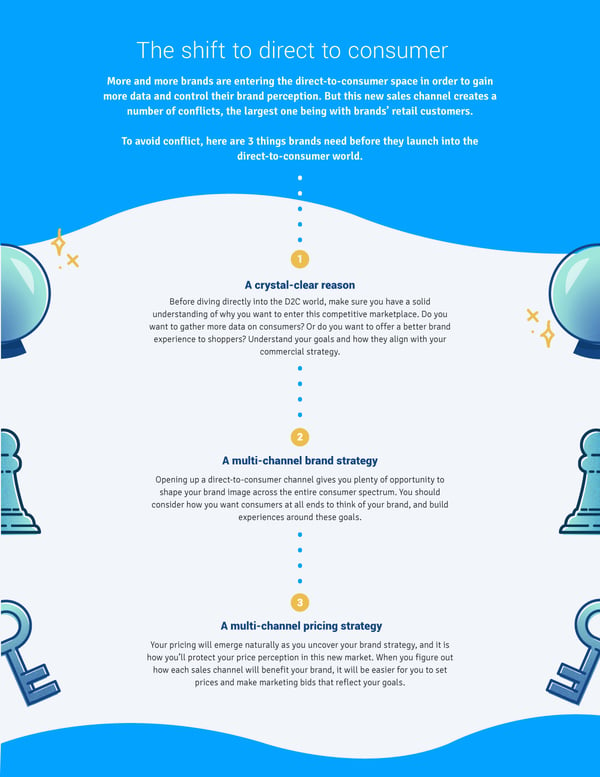A new trend in retail is the rise of the number of brands entering the direct-to-consumer (D2C) space.
Instead of selling their products to retailers, who then turn around and sell their products to consumers, some brands are now skipping the retailer and going straight to shoppers. And in a new marketplace where it’s easy to connect with consumers via e-commerce and social media, it’s easier than ever to do. The Internet and e-commerce have shifted how we shop, and brands need to respond accordingly to keep up with market demands.
No matter the reason why more brands are entering this space, one thing is certain: this leap directly to consumers means brands are now in uncharted territory. The channel also creates some conflicts between brands and retailers, who might see your new D2C strategy as a threat to their bottom line, and a poorly-planned strategy can have disastrous consequences on your brand perception.
So what do brands need for a successful transition into the direct-to-consumer world? Here are the 3 things you need before you get started.
1. A crystal-clear reason
Before diving directly into the D2C world, make sure you have a solid understanding of why you want to enter this competitive marketplace.
For some brands, it’s a matter of data. In the current marketplace, retailers tend to hold their consumer data close to their chests as their main competitive advantage. If you open up a D2C channel though, you can gather consumer data to help you improve your relationship with consumers, get product insights, and spur product innovation.
Another reason many brands are making this move is to protect their brand name and offer a better brand experience. In a marketplace where product quality is evening out, brand loyalty and perception might be the key to many consumers’ hearts. Since retailers, not brands, dictate shopper experience in-store and online, brands can understandably worry about their image and price perception. The move directly to consumers, then allows brands to exert a certain amount of control over the market that they previously couldn’t attain.
Finally, a new D2C channel can simply be an avenue to more sales. If consumers have more chances and ways to buy, it might boost your bottom line.
No matter the reason, if you’re a brand and you want to move into the direct to consumer space you should thoroughly understand why you want to make the move. This will help you create better strategies within the market so you can achieve your goals and align your commercial strategy.
Additionally, you might find that a retailer might be better suited to help you achieve your goals. If you want to ensure a better brand experience, for example, a retail partnership could help both parties grow.
2. A multi-channel brand strategy
After clarifying why you want to go direct-to-consumer, it’s time to set up a multi-channel brand strategy to establish how you’re going to execute your plan.
A strategy is all about a certain choices that you make in order to drive profitable growth. There are multiple moving parts to a strategy, but at its core is a goal of what you’re going to do, and a plan for how to achieve that goal.
You should think about:
- Which channels do we want to cover, and how will we win those markets?
- What are my goals and aspirations for each of my channels?
- Is one channel better suited to achieve a certain goal than another?
- How do we want consumers to perceive our product in each channel?
- What do we need as an organization in order to make those wins?
These are just a few of the questions you’ll need to consider. And without help, the multi-channel brand strategy can quickly get overwhelming. At Omnia, we recommend you use a consultant to help you sort through your strategy and come up with an easy plan to follow. To see who we trust to help you with this, take a look at our Partners page.
Differentiating your assortment
Your multi-channel brand strategy needs to cover all of your sales channels, not just your direct-to-consumer one. Your retail channel is a huge part of that.
If you’re selling directly to consumers, you immediately become competition to many retailers. And when retailers are your biggest buyer, how can you reap the benefits of selling directly to consumers without fracturing your relationship with retailers?
One of the easiest and best ways, according to Roger van Engelen and Jean-Paul Savelkoul of our partner marketing agency A.T. Kearney, is to differentiate your assortment. In other words, you should offer retailers different products than you offer to consumers.
What this looks like in practice is creating personalized, tailored experiences for consumers who come directly to your brand, while the retailers take care of the mass sales of more generic products. In the end, you as a brand can still gather consumer information and protect your brand identity, while retailers can still make mass sales on your high-performing products. A great example of a company that does this exceptionally well is Nike.
3. A multi-channel pricing strategy
A multi-channel pricing strategy is a natural result of a multi-channel brand strategy.
As you figure out how each sales channel will benefit your brand, it will be easier to set prices and make marketing bids that reflect your goals. If you want to position your brand based on perceived product value, you’ll probably use higher prices. If you want your brand to be known as the cheapest source for goods, you’ll likely use charm pricing.
Your price point in the D2C channel should reflect your overall commercial strategy, of course, but it should also align with the rest of the retail market for two reasons.
First, your price affects your brand image. Pricing yourself drastically higher or lower than retailers and the rest of the market will confuse consumers and negatively affect your price perception. Consumers might feel cheated by one source or the other, and won’t know where to place the value in the product. If you make this mistake, regaining consumer trust and value is a hard hurdle to overcome.
Second, pricing yourself dramatically higher or lower will also affect your relationship with retailers. If your D2C price is notably lower than the rest of the online retailers selling the same product, you instantly undercut your biggest customers.
Brands, dynamic pricing, and the D2C market
Keeping your prices aligned with retailers for every product in your assortment at all times is a daunting task, to say the least. That’s why Roger van Engelen, Principal at A.T. Kearney thinks that a dynamic pricing software is essential for brands that are creating D2C sales channel.
“In my opinion, brands need to have dynamic pricing before they start selling directly to consumers because it will prevent them from agitating their retail customers. This, in turn, protects brands from triggering a price-markdown war, which helps protect brand price perception.” - Roger van Engelen. See interview.
Most major retailers already use dynamic pricing to manage their online stores and keep their products competitively priced. Brands, on the other hand, can use the software to follow a market price within extremely tight limits. This not only keeps your relationships with retailers friendly, but also prevents you from kick-starting a market-wide race to the bottom.

Protect your brand and your relationships with Dynamic Pricing
Follow the online marketplace, automatically adjust your prices, and keep your prices aligned with your retail customers in just a few clicks. Dynamic Pricing for Brands keeps you aligned with your partners and strategy while giving you more data on your consumers.
Try Dynamic Pricing free for 2 weeks and see for yourself how you can build a better brand-to-consumer strategy. Click the button below to get started.




.png?height=766&name=Untitled%20design%20(21).png)

